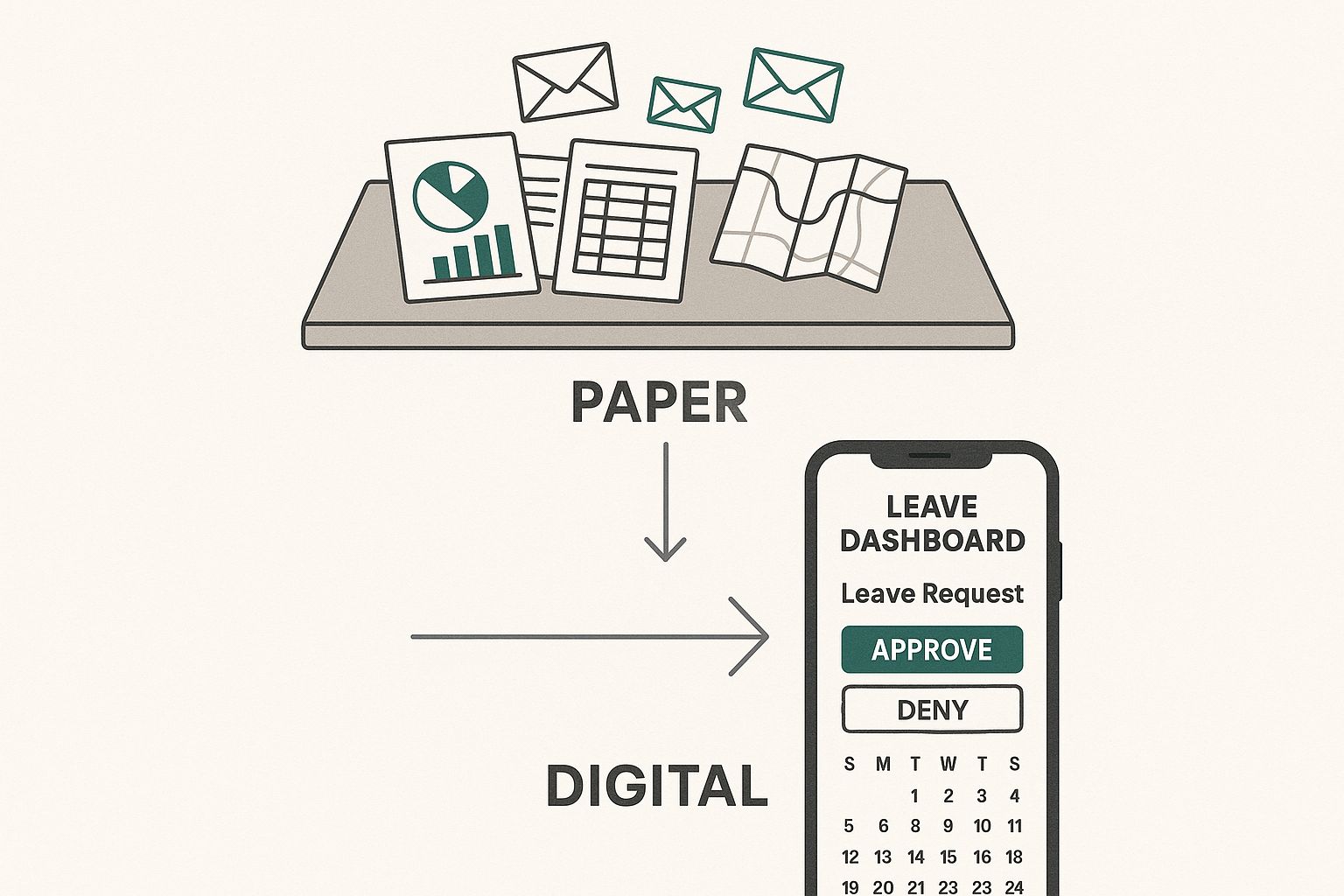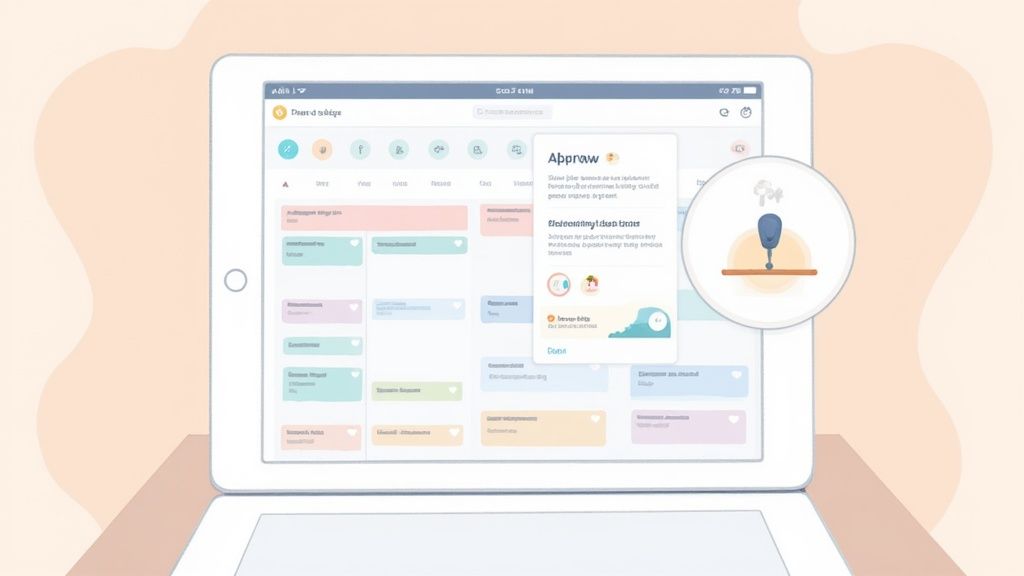
A Guide to Online Leave Management Systems
Posted by Robin on 15 Oct, 2025 in
An online leave management system is a digital tool designed to automate everything related to staff time off. Think of it as the central command centre for holiday requests, absence tracking, and leave approvals, replacing the clunky spreadsheets and never-ending email chains of the past.
Moving Beyond Spreadsheets and Emails
Trying to manage your team's holiday requests using spreadsheets and email is a bit like navigating London during rush hour with a paper A-to-Z. It's chaotic, hopelessly outdated, and you're almost guaranteed to make a wrong turn. An online leave management system is your modern-day GPS, turning a disjointed and frustrating task into a smooth, digital workflow.
For many UK businesses, the old way of doing things is a constant source of headaches. Lost email requests, accidental double-bookings during the busiest times of the year, and the mind-numbing task of calculating pro-rata holiday entitlements are all too common. These manual methods don't just kill productivity; they create a lack of clarity that can seriously damage team morale.
The Cost of Manual Tracking
When leave is handled manually, the problems go far beyond simple inconvenience. A simple slip-up in tracking can lead to a breach of UK employment law or mistakes in payroll, creating some serious financial and legal headaches. On top of that, the administrative load on managers and HR is huge, pulling them away from the work that really matters.
A digital system provides a single source of truth for all leave-related data. It gets rid of the guesswork, ensures policies are applied fairly, and gives everyone—from employees to senior management—a clear view of who's in and who's out.
The shift to modern tools is already happening. In the UK, the need for better ways to handle absences has shot up, especially as flexible working has become the norm. Data from the leave industry reveals that digital systems now process millions of employee leave movements every year. For instance, one UK platform alone logged over 3.2 million annual leave bookings, 327,000 absences, and 195,000 work-from-home requests in just one year. You can explore more data on the modern leave industry to see just how big this change is.
The infographic below perfectly illustrates the move from messy, manual processes to a clean, digital approach.

As you can see, an online system consolidates all those scattered paper trails and emails into one organised dashboard. It makes managing time off simple, clear, and efficient for everyone involved.
Essential Features of a Modern Leave System

A proper online leave management system is a world away from a shared digital calendar. It’s an intelligent platform packed with specific tools designed to fix the real-world headaches that come with managing staff time off. When you dig into these core features, it becomes obvious why ditching spreadsheets isn't just about convenience—it's a smart business move.
At its most basic, the system gives your staff a simple, self-service portal. This empowers them to check their own leave balances, see who else is off, and put in requests without having to bother HR or their manager. That one feature alone cuts out a huge amount of admin chatter, freeing everyone up to focus on their actual jobs.
Automated Approval Workflows
One of the most valuable features is the ability to automate approval workflows. Instead of an email request getting buried in a manager’s overflowing inbox, a leave request is instantly routed to the right person—or people—for the green light.
You can set up multi-level approvals, so a request might go to a team leader first, then on to the head of the department. The system handles the entire chain of command, sending reminders and notifications until the request is either approved or denied. This creates a clear, auditable trail every single time.
An effective leave management system ensures every request is handled fairly and sticks to company policy. It gets rid of guesswork and provides a consistent experience for all staff, which is vital for keeping morale and trust high.
Centralised Team Calendars
Visibility is everything. A shared, real-time calendar gives managers and team members an instant snapshot of who is away and when. This simple overview helps prevent accidental overlaps and makes planning resources for important projects so much easier.
Imagine a project manager sees that two key developers have requested overlapping holidays. They can spot the potential bottleneck weeks in advance and sort it out before it becomes a problem. This kind of proactive scheduling is pretty much impossible when you're juggling scattered spreadsheets.
Customisable Leave Policies
Businesses in the UK have to navigate specific employment laws, from statutory holiday entitlements to working out pro-rata leave for part-time staff. A modern system must allow for fully customisable leave policies that reflect these rules down to the letter.
This means having the flexibility to:
- Define different leave types: Set up separate categories for annual leave, sick days, compassionate leave, and anything else you offer.
- Automate accruals: Let the system automatically calculate and add leave entitlements based on an employee's contract or how long they've been with the company.
- Handle carry-over rules: Configure clear policies for what happens to unused leave at the end of the year.
This level of customisation ensures your company stays compliant with UK law while accurately tracking every type of absence. It also means the online leave management system fits your business like a glove, not the other way around.
Why Your Business Needs a Leave Management Platform
Knowing the features of an online leave management system is one thing, but really understanding what it can do for your business is a different story entirely. Making the switch from manual methods isn't just a small upgrade; it's a strategic move that pays real dividends in efficiency, legal compliance, and even team morale. The true value is seeing how those features solve actual business problems.
Think about a classic headache for UK managers. You have a massive project deadline on the horizon, but two of your key players have just requested overlapping holidays. If you're using a spreadsheet, you might not spot that clash until it's far too late, leading to a last-minute panic to shuffle workloads. A proper platform would flag that conflict the moment the second request comes in, letting you plan ahead and avoid the disruption altogether.
Boost Productivity and Slash Admin Time
Let's be honest: manual leave tracking is an administrative black hole. HR staff and line managers burn countless hours answering requests, updating messy spreadsheets, calculating balances, and fielding the same simple questions over and over. This is precious time that could be invested in things that actually grow the business, like training or improving the company culture.
An automated system takes all that repetitive work off your plate. Employees can help themselves by checking their own leave balances and viewing the team calendar before they even think about making a request. This one simple change drastically reduces the endless back-and-forth emails and messages.
A well-chosen leave management system can cut the time HR spends on leave admin by as much as 50%. This frees up your people to focus on work that drives real value, instead of getting bogged down in paperwork.
Ensure Compliance and Prevent Payroll Errors
For any UK business, staying on the right side of employment law is non-negotiable. Manually figuring out pro-rata holiday for part-time staff or keeping track of statutory sick pay is just asking for trouble. One tiny mistake can mushroom into a costly payroll error or, worse, a legal challenge. An online system handles these tricky calculations automatically, ensuring you get it right every time.
By creating a clear, digital audit trail for every single leave request and approval, you have a rock-solid record of everything. This not only protects your business but also ensures your leave policies are applied fairly and consistently to everyone in the organisation. You can discover more about the key benefits of absence management software for SMEs in our detailed guide.
Make Smarter Plans with Better Data
Having a clear view of absence trends is an incredibly powerful tool for workforce planning. An online leave management system gives you insightful reports that help you spot potential burnout risks, plan cover for seasonal holiday peaks, and make staffing decisions based on actual data, not just guesswork.
This kind of insight is becoming absolutely essential as work patterns change. The UK market is seeing a huge uptake in these systems, largely driven by the move to hybrid working where tracking who is where has become far more complex. Modern platforms help you manage your workforce better by integrating with tools like Outlook and giving you the real-time data you need to make informed decisions.
Choosing the Right System for Your Company
Picking the right online leave management system is a big decision, one that will echo through your company’s day-to-day operations for years. It’s easy to get distracted by fancy bells and whistles, but the real win comes from focusing on the core functions that will actually help your business and your people. This isn't just about buying a piece of software; it's an investment in a smoother workflow that fits how you operate.
Before you even start looking at vendors, take a moment to map out your current pain points. Are you constantly wrestling with calculating pro-rata holiday for part-time staff? Do overlapping leave requests regularly throw projects off schedule? Pinpointing your specific challenges gives you a solid benchmark for measuring up potential systems. As you start your search, it can be useful to look at general guidance on selecting management software, even if it's from a different field, just to get your head around the key things to look for.
Assessing Key Vendor Criteria
Once you know exactly what you need to fix, you can start vetting potential providers with a much sharper eye. First and foremost, a user-friendly interface is non-negotiable. If the system is clunky or confusing, your team simply won't use it, and the whole investment is wasted.
Here are the essential questions you should be asking any potential vendor:
- Scalability: Can this system comfortably grow with us? Or will we be back to square one, looking for a new platform in a couple of years?
- Integration: How smoothly does it talk to our existing tools, like our payroll software, Slack, or Google Calendar?
- Mobile Access: Is there a proper mobile app for staff to request leave and for managers to approve it while they're out and about?
- Data Security: How is our employee data being protected, and does the system fully comply with UK GDPR?
For any UK business, GDPR compliance isn't just a nice-to-have feature—it's a legal must. Make sure any vendor can show you clear proof of their data security and handling protocols before you even think about signing a contract.
Making the Final Choice
Your final decision should be a practical one, balancing features against your real-world needs. The goal is to find a system that automates your most tedious tasks but is still flexible enough to handle your specific leave policies. To get a much deeper dive into this process, check out our detailed guide on the secrets of choosing the right absence management solution.
At the end of the day, the best online leave management system is the one that makes life simpler for everyone. It should give employees easy self-service access, provide managers with the clarity they need for planning, and free up your HR team to focus on bigger, more strategic work.
Implementing Your New System for Success
Rolling out a new online leave management system successfully is less about the fancy tech and much more about the people who’ll be using it day in, day out. A smooth transition hinges on a thoughtful plan that handles the technical setup but, more importantly, addresses the human side of change. The goal is to make sure the new tool is seen as a genuine help, not just another directive from the top.
The technical bits, while critical, are often the easy part. This is where you’ll move existing leave data from old spreadsheets and set up the new system to perfectly reflect your company's unique leave policies. You’ll need to define your different leave types, sort out accrual rates, and establish the approval workflows that actually work for your teams.
Fostering Genuine Buy-In
Getting your team on board is where the real work starts. The trick is to present the system as a tool that gives everyone more control. For staff, it means they can finally see their own leave balances and check team availability without having to chase anyone for answers. For managers, it brings the clarity they need to plan properly.
To build this positive energy, communication is everything. Announce the change well ahead of time and spell out exactly what’s in it for each person.
- Highlight employee benefits: Talk about how easy it is to request time off and get instant access to their own leave records.
- Showcase manager advantages: Focus on how the system makes approvals a breeze and prevents those frustrating scheduling clashes.
- Provide clear training: Run short, practical training sessions to show just how simple the new process really is.
A common mistake is to get bogged down in what the system does, instead of what it does for your team. When people understand how it makes their own working lives easier, you’ll get enthusiastic adoption rather than reluctant compliance.
A Phased and Supported Rollout
Think about a phased rollout. You could start with a single department as a pilot group, which lets you gather feedback and iron out any kinks before going company-wide. It’s also vital to provide accessible support, like a go-to person for questions, to make sure any early confusion is sorted out quickly.
Ultimately, a well-managed implementation turns the system from a simple admin tool into a core part of your daily operations from day one. To help you get it right, we’ve put together a step-by-step guide to implementing an absence management system that covers these key stages in more detail.
Supporting Well-being in the Modern UK Workplace

More than just an admin tool, an online leave management system is a surprisingly powerful way to protect your team's well-being. This is especially true in the UK's current mix of hybrid and flexible working, where the lines between work and home life can get incredibly blurry.
The real magic is in how it helps create and enforce clear boundaries. The system gives everyone total visibility of who is away and when. This simple act helps managers protect their team’s downtime, discouraging those "just one quick question" emails and fostering a culture where time off is genuinely respected.
Countering the Rise of Leavism
One of the biggest challenges facing UK workplaces right now is ‘leavism’ – the unhealthy habit of working while on annual leave. It's a trend that completely defeats the purpose of taking a break in the first place.
The numbers are quite concerning. A 2023 survey of UK workers revealed that a massive 59% admitted to working while on holiday. Worse still, one in five actually took their work laptops with them. This "always on" mentality is a fast track to burnout.
An online leave management system acts as a structural defence against leavism. By formalising and visualising time off, it reinforces the message that holidays are for rest, not remote work, helping to prevent burnout before it takes hold.
This isn't just about HR efficiency; it’s a proactive investment in your team's mental health and long-term performance. For businesses that want to go a step further, integrating this with comprehensive occupational health services can be a game-changer. By making sure people take proper, uninterrupted breaks, you build a healthier, more resilient, and more engaged workforce.
Still Have Questions? Let's Clear Things Up
Even after seeing all the benefits, it's completely normal to have a few practical questions swimming around in your head before you jump in. It's a big decision, after all.
So, let's tackle some of the most common queries we hear from UK businesses, giving you the straightforward answers you need to feel confident about making the switch.
What’s This Going to Cost Us?
You'd be surprised. Most modern leave management systems are genuinely affordable, especially for small and medium-sized businesses. The most common setup is a subscription model, which usually works out to just a few pounds per employee, per month.
This kind of clear, predictable pricing makes it incredibly easy to work out your total cost. You can then stack that number up against the hours you'll save on admin, and the value becomes obvious. Some providers might offer a one-time license fee, so it’s always worth checking which model fits your budget best.
Is Our Company Data Actually Secure?
This is a big one, and rightly so for any UK business. Reputable providers take data security incredibly seriously—they have to be fully compliant with GDPR. Your employee data should be stored on secure cloud-based servers, with daily backups in place to make sure nothing ever gets lost.
Before you commit to any system, always ask about their security protocols and data protection policies. They should be able to hand over clear documentation explaining exactly how they keep your sensitive information safe. If they can't, walk away.
Can We Make It Work with Our Specific Policies?
Absolutely. In fact, if a system can't be tailored to your rules, it's not the right system for you. A key feature of any decent platform is its flexibility. You should be able to create and manage multiple, custom leave types that perfectly mirror your company’s policies—whether that's for annual leave, sick days, compassionate leave, or something unique to your business.
This flexibility should also extend to setting up specific accrual rules, like calculating pro-rata holiday for part-timers, and defining your carry-over rules at the end of the year. The whole point is for the system to adapt to you, not the other way around.
Isn't This Just for Big Companies?
Not at all. While large organisations see massive benefits, an online leave management system is just as valuable for small and growing businesses. Honestly, putting a system in place early on is one of the smartest things you can do. It builds good habits from the start and saves you from the inevitable administrative chaos that comes with tracking leave manually as your team gets bigger.
Modern systems are built to scale. They can support a company with five employees just as smoothly as one with five hundred.
Ready to finally ditch the spreadsheets and get a clear, real-time view of who's in and who's off? Leavetrack simplifies every single step, from request to approval, saving you time and preventing those frustrating scheduling conflicts. See for yourself how our intuitive platform can bring total transparency and efficiency to your leave management. Learn more about Leavetrack and start your free trial today.
